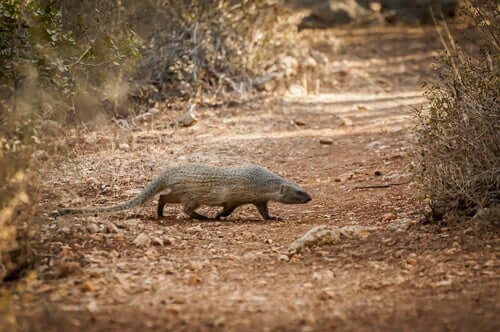The Egyptian Mongoose: How Did It Get to Spain?


Written and verified by the vet Eugenio Fernández Suárez
The Egyptian mongoose is a predator that not many people in Spain (or elsewhere) know about. That’s probably because it’s the kind of animal we’re used to seeing in Africa. In fact, this breed of mongoose is the only one you’ll find in Europe, and only one in the south of Spain.
The Egyptian mongoose: a strange animal to see in Europe
The Egyptian mongoose has a long body, similar to a weasel. Their fur tends to be a uniform mix between brown and gray. Like the animals in the weasel family (Mustelidae), they have short legs and nonretractile claws that help them dig. Their diet consists mainly of rodents that they hunt.
Their eyes are also very strange. They’re one of the few mammals that have a horizontal pupil, which gives them a very unique appearance.
But what’s truly fascinating about this African carnivore is how exactly it made it to Europe. As far as we can tell, it was actually people who introduced them into the Iberian Peninsula (Spain and Portugal), like they did with the genet.

The origins of the Egyptian mongoose in Spain are still hotly debated. Many people say that various civilizations like the Phoenicians, Carthaginians, or Moors first introduced them into Spain.
They must have brought it to Spain for the same reasons that it was basically a pet in Ancient Egypt: they’re great at pest control. The Egyptian mongoose was probably an invasive species before the concept even existed. Although it seems to have integrated well into the ecosystem in Doñana National Park.
The oldest Egyptian mongoose in Spain
A recent archaeological finding seems to give a clue to the origins of the Egyptian mongoose in Spain. They were doing a dig at the Roman ruins in Mérida (Spain) and found remains of Egyptian mongooses among other domestic animals (mostly dogs), like they were just another pet. There were clear signs these animals were pets, like healed bone fractures.
That would make it the oldest known Egyptian mongoose in Spain, which means that the theory that the Moors brought it can’t be true. This finding essentially confirms that there were Egyptian mongooses in Spain 2,000 years ago, and that they had a strong relationship with humans.

Ritual sacrifice
The tomb seemed to involve some kind of ritual sacrifice. This was common with dogs in Roman times, but we’d never seen it with an Egyptian mongoose before. That might mean that they lived with families in the same way dogs do now. Dogs were so important to them that they appear in Roman myths, like the three-headed dog, Cerberus.
Their bodies were also surrounded by lots of cups and food scraps. There were three tombs like this, which suggests that it was a festival or ritual in honor of a god.
This also isn’t the only Egyptian mongoose that scientists have discovered recently. In the Castelo de Palmela (Portugal), and near Lisbon, they’ve found Egyptian mongooses from similar time periods. But the circumstances are different: these ones seemed to be wild, and lived in caves.
Does that mean that the Romans are the ones who brought this species of mongoose? Not necessarily. It just means that they were there during the Roman period, so they might have been there before, too. Their origins in Spain could actually go way, way farther back than the Romans. We’ll have to keep digging to find out!
The Egyptian mongoose is a predator that not many people in Spain (or elsewhere) know about. That’s probably because it’s the kind of animal we’re used to seeing in Africa. In fact, this breed of mongoose is the only one you’ll find in Europe, and only one in the south of Spain.
The Egyptian mongoose: a strange animal to see in Europe
The Egyptian mongoose has a long body, similar to a weasel. Their fur tends to be a uniform mix between brown and gray. Like the animals in the weasel family (Mustelidae), they have short legs and nonretractile claws that help them dig. Their diet consists mainly of rodents that they hunt.
Their eyes are also very strange. They’re one of the few mammals that have a horizontal pupil, which gives them a very unique appearance.
But what’s truly fascinating about this African carnivore is how exactly it made it to Europe. As far as we can tell, it was actually people who introduced them into the Iberian Peninsula (Spain and Portugal), like they did with the genet.

The origins of the Egyptian mongoose in Spain are still hotly debated. Many people say that various civilizations like the Phoenicians, Carthaginians, or Moors first introduced them into Spain.
They must have brought it to Spain for the same reasons that it was basically a pet in Ancient Egypt: they’re great at pest control. The Egyptian mongoose was probably an invasive species before the concept even existed. Although it seems to have integrated well into the ecosystem in Doñana National Park.
The oldest Egyptian mongoose in Spain
A recent archaeological finding seems to give a clue to the origins of the Egyptian mongoose in Spain. They were doing a dig at the Roman ruins in Mérida (Spain) and found remains of Egyptian mongooses among other domestic animals (mostly dogs), like they were just another pet. There were clear signs these animals were pets, like healed bone fractures.
That would make it the oldest known Egyptian mongoose in Spain, which means that the theory that the Moors brought it can’t be true. This finding essentially confirms that there were Egyptian mongooses in Spain 2,000 years ago, and that they had a strong relationship with humans.

Ritual sacrifice
The tomb seemed to involve some kind of ritual sacrifice. This was common with dogs in Roman times, but we’d never seen it with an Egyptian mongoose before. That might mean that they lived with families in the same way dogs do now. Dogs were so important to them that they appear in Roman myths, like the three-headed dog, Cerberus.
Their bodies were also surrounded by lots of cups and food scraps. There were three tombs like this, which suggests that it was a festival or ritual in honor of a god.
This also isn’t the only Egyptian mongoose that scientists have discovered recently. In the Castelo de Palmela (Portugal), and near Lisbon, they’ve found Egyptian mongooses from similar time periods. But the circumstances are different: these ones seemed to be wild, and lived in caves.
Does that mean that the Romans are the ones who brought this species of mongoose? Not necessarily. It just means that they were there during the Roman period, so they might have been there before, too. Their origins in Spain could actually go way, way farther back than the Romans. We’ll have to keep digging to find out!
This text is provided for informational purposes only and does not replace consultation with a professional. If in doubt, consult your specialist.








